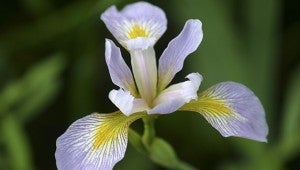Arboretum Paths: Native iris is blooming at the Arboretum
Published 7:00 am Wednesday, April 16, 2014

SOMETHING BORROWED, SOMETHING BLUE: Southern blue flag iris (Iris virginica) are blooming in the Arboretum’s Aquatic Exhibit.
Crosby Arboretum Archive Photo
Patricia Drackett
Director, Crosby Arboretum/ MSU Extension
Many visitors naturally assume that the beautiful iris they see in our Aquatic Exhibit are “Louisiana iris”. However, the iris that is most commonly seen in our pond are southern blue flag iris (Iris virginica) At one time there were some Louisiana iris hybrids planted into our Piney Woods Pond, but they are no longer evident. Now and then we will catch sight of a lovely copper iris (Iris fulva), one of the five native North American species that are bred to produce a spectacular array of named cultivars.
The southern blue flag iris found at the edges of the Piney Woods Pond is a low-care garden favorite. Common in the rich, moist soils of coastal wetlands from Virginia to Texas, these perennials are native to areas where water stands year-round. The purple or blue flowers are found in various hues, having sword-like leaves typically around two to three feet in height, although they can get as tall as four feet or more.
Blue flag iris blooms most abundantly in full sun in wet locations, but it also does well in areas of shifting shade from a nearby forest canopy. And while it works well growing in the shallow water at a pond’s edge or a drainage ditch, it will also perform nicely in a regular garden soil if it is kept moist with regular watering.
Southern blue flag iris plant spreads by rhizomes, which can be divided, and is extremely easy to propagate by seed. In my first year with the Arboretum, I remember being amazed at a huge pot full of several dozen baby iris that grounds manager Terry Johnson had started from a single seed pod, that kept getting bigger and bigger.
Growing among our stands of iris, you will discover two species of native cypress trees (Taxodium) found at the Arboretum that offer excellent fast-growing choices for the continually damp areas in your home garden. Stand on the edge of our Pinecote Pavilion and look slightly to your left to the area called Cypress Head. Follow the Pond Journey to this area and the overlook surrounded by pond cypress (Taxodium ascendens) and bald cypress (Taxodium distichum).
Near Cypress Head, a pink honeysuckle azalea is flowering. As this plant wanes, the stage will be grabbed by the orange and gold hues of the Florida flame azalea (Rhododendron austrinum). Be sure to take a whiff of the delightful fragrance when you pass a honeysuckle azalea!
Pond cypress occurs naturally in wet savannas and shallow ponds, while bald cypress is found in much wetter areas such as swamps, floodplains, and bottomlands. However, both species will grow just fine in your home garden in much drier areas, and both do best in full sun. Pond cypress is sometimes billed as the “kneeless cypress”, and although it will still form “knees” from the roots, they seem to be much smaller than those of bald cypress.
Mark your calendar for the Arboretum’s Earth Day on Saturday, April 26 from 11a.m. to 2 p.m. Bring the family out for a fun day celebrating the 44th anniversary of Earth Day. Children will especially enjoy the “Kids Go Green” crafts activities led by Master Naturalist Mary Cordray. Visit exhibits that will focus on nature and sustainable gardening. The Pearl River Master Gardeners will have a table. Bring your questions! Members free; non-members, $5 for adults and $2 for children.
A special night insect collecting event will be offered on Friday evening, May 2, from 6:30 to 9:30 p.m., led by Hancock County Extension Agent Christian Stephenson. This will be a small night collecting event for adults and children of ages. Scout groups and homeschool groups will find this event of interest. This is the time when many spring insects are emerging. Keep in mind this is a small event, not be like our “all hands on deck” two-day BugFest event in September. Please call to sign up for this program. Collecting equipment will be provided, just bring your flashlight. Admission is free admission for members, non-members, $5 for adults and $2 for children.
For more information or to sign up for a class, call (601) 799-2311 or visit the website at www.crosbyarboretum.msstate.edu. The Arboretum is open Wednesday through Sunday from 9 a.m. to 5 p.m. and located in Picayune, off I-59 Exit 4, at 370 Ridge Road (south of Walmart and adjacent to I-59).
FOR FURTHER EXPLORATION: Visit the MSU Extension website at www.MSUcares.com to read more about the five species of Louisiana iris that are bred to produce the hybrids, and about common iris species that are assumed to be Louisiana iris, but are not.


